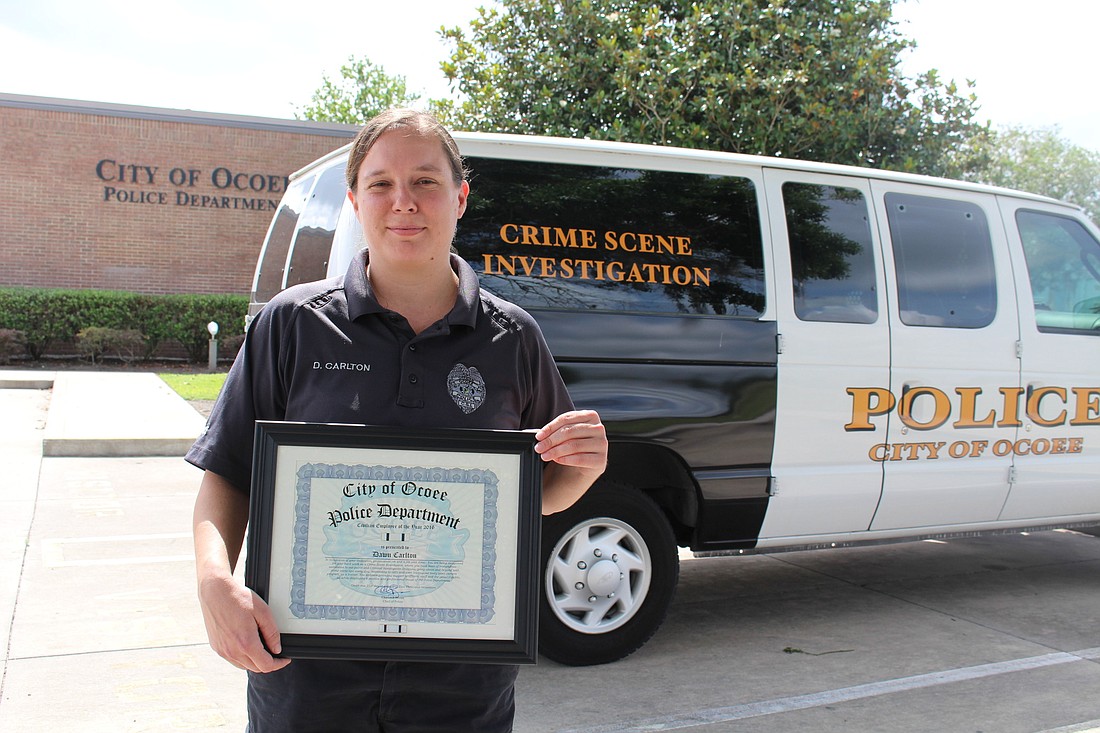- April 23, 2024
-
-
Loading

Loading

OCOEE If you were trying to guess Dawn Carlton’s occupation, the Sherlock Holmes toy figurine and decorative magnifying glass adorning her office desk would serve as telltale clues.
That’s because Carlton, who also has a labrador named Sherlock, is the Ocoee Police Department’s only crime scene investigator — a position that requires her to use science and logic to help solve cases in a similar manner as the fictional British detective.
In her role, Carlton, 33, spends much of her time in the field photographing crime scenes and collecting physical evidence to assist police detectives assigned to challenging cases.
Her academic background in biology and prior experience in fingerprint analysis at the Florida Department of Law Enforcement is what earned her the position from a pool of more than 1,000 applicants, said Ocoee Police Deputy Chief Steve McCosker.
And Carlton, who was hired in May 2016 and received the Civilian of the Year award from the city of Ocoee, is the department’s first CSI. So far, she has worked on an estimated 100 cases, each with its own unique set of challenges.
Carlton views the process of her job as a puzzle, she said, while adding that despite what popular CSI shows portray, sometimes the circumstances of a case may create a puzzle with too many missing pieces.
“The most challenging part is when you have a scene and you don’t get anything because you don’t always get something,” Carlton said. “There’s this term called the CSI effect where you see on TV shows that every crime has blood, 30 fingerprints, three shoeprints and 40 different calibers all compared to the gun that they found in the sewer — but that’s not how real crime scenes work. So the most frustrating part is when I go to a crime scene, and there just isn’t enough tactical evidence.”
When she responds to a crime scene, Carlton uses a fingerprint brush and a variety of different powders that come in handy depending on the type of surface she needs to dust for prints. If firearms were involved, she might opt for metal detectors to locate bullet casings or measuring devices to calculate distances that could serve as valuable data to detectives or jurors.
Although Carlton is the department’s only CSI, McCosker explained other officers are also partially trained in the basics of evidence collection and the annual caseload, at present, does not justify hiring a second investigator.
“It’s important to have someone trained like Dawn, because if you didn’t have certain cases last year then that means nobody got any experience in processing those types of crime scenes,” McCosker said. “So now when those types of cases do happen, we’ll have an expert to go and take care of that for us, and then our detectives can actually focus on doing the human side of it, you know, speaking to people, gathering statements and hunting down leads.”
After graduating from the University of Louisville in Kentucky, Carlton took a job in South Korea, where she taught English. Using the money she saved, she got a scuba diving internship in the Philippines and then worked as a scuba diving instructor in Singapore, Malaysia and Thailand.
As an instructor, she said, she was paid to chase sharks and maneuver herself around underwater coral reefs, but she never predicted she’d also find herself squeezing through strange places for her job as an investigator — this time, to chase criminals.
“I have to go, basically, where the suspects enter, so if they climb through a hole in the wall, then I generally do as well, because I’m looking for things that have been left behind, like fingerprints or pieces of their clothing or maybe even their wallet if it dropped out of their pocket,” she said. “So, sometimes I find myself climbing out of the trunk of a car with 15 bullet holes thinking, ‘How did I end up here?’”
Although it sometimes places her in strange spaces, Carlton emphasized how much she loves her job. Finding physical evidence — whether in the form of DNA, fingerprints, gun casings, or even shoe prints — can sometimes make all the difference between a solved or unsolved case.
“I chose crime scene because you get to go out and process evidence, and it was still in my field of science,” Carlton said.
–––
Contact Gabby Baquero at [email protected].